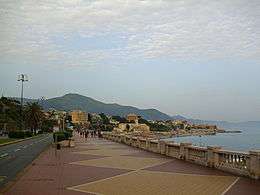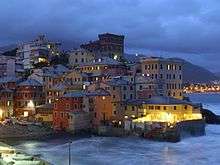Albaro
Albaro is a residential neighbourhood of the Italian city of Genoa, located 3 kilometres (1.9 mi) east of the city centre. It was formerly an independent comune, named San Francesco d'Albaro, included in the city of Genoa in 1873. At present, together with the neighbourhoods of Foce and San Martino d'Albaro is part of the Genoa's city VIII Municipio (Medio Levante).
Albaro | |
|---|---|
Villa Saluzzo Bombrini, called "Il Paradiso" ("the Heaven"), one of the most renowned villas of Albaro | |
 Albaro Location in Italy | |
| Coordinates: 44°23′57″N 8°57′39″E | |
| Country | Italy |
| Region | Liguria |
| Province | Province of Genoa |
| Comune | Genoa |
| Population | |
| • Total | 28,465 |
| Area code(s) | 010 |
For few months, from September 1822 to July 1823, the romantic poet Lord Byron lived here. The English writer Charles Dickens spent in Albaro the summer of 1844, and here he wrote the short novel The Chimes.
From the 16th to the 19th century Albaro was a renowned holiday resort for the Genoese upper class, who lived in the city and during summer used to move to their villas in Albaro. Nowadays it is a stately residential neighborhood, where during the last century next to the historic villas apartment buildings have been built, most of them with broad exclusive green spaces.
A well known hamlet of Albaro is Boccadasse, a fishermen's village at the eastern side of Corso Italia.
Etymology
According to the historian Federico Donaver (1861–1915), Albaro would take its name from the ancient Ligurian word arbà, which means bay; another hypothesis (still by Donaver itself) presumes that it derives from dawn (Italian alba), as Albaro hill is located east of the city of Genoa, therefore where the sun rises.

Demographics
At 31 December 2015 were 28,465 people living in Albaro, with a population density of 96.38 people per km².[1]
Geography
Albaro is located east of the center of Genoa. The neighborhood includes the southernmost part of a hill between the rivers Bisagno and Sturla which ends at the sea with high cliffs and small stony beaches, once accessible only through narrow crêuze.[2] Nowadays along the coast line runs the seafront named Corso Italia.

Albaro includes most of the territory of the former comune of San Francesco d'Albaro, except some small areas, and its boundaries are the sea coast (Corso Italia), Via Nizza and Via Pozzo on the west side, Corso Gastaldi on the north side, via Sclopis and via Orlando on the east side.
History
Till 15th century Albaro hill was a rural area, populated only by few peasants, with vegetable gardens, vineyards and some monasteries. No settlements were along the coast, except the fishermen's village of Boccadasse, where a small cove allowed the landing of boats.[3]
Since the 16th century Genoese aristocratic families built large villas in the surrounding of the city, and Albaro became one of their preferred places where spend summer time.[3] The period of villas ended at the end of 18th century with the decline of the Republic of Genoa and its annexation to the Kingdom of Sardinia.
In 1873 the comune of San Francesco d'Albaro, together with other 6 communes neighboring to Genoa, was included in the municipality of Genoa and with the master plan of 1906 began a process of urban development. New roads were opened, suitable for car traffic, the villas gardens were divided into lots, so creating a stately and exclusive residential neighbourhood for Genoese upper class.[3][4][5]
Architecture
Villas and palaces
In the early 16th century, the aristocratic families of Genoese ruling class built their villas, designed by the best architects, in the surroundings of the city. The hill of Albaro, for its proximity to the city, became a favorite vacation site for the Genoese upper class, who in summer moved there to spend the hot season.[3] Originally the villas were productive agricultural centers, but later they were transformed into summer stately mansions, enriched with works of art and large parks. The construction of the villas continued during the following centuries, till to 18th century. During the 19th century the rich entrepreneurial class took the place of the aristocratic. They built small villas, while the historic houses, no longer appropriate for the new needs, were divided into apartments or handed over to religious communities.[3]
Even today the renovated historic mansions are in part are divided into apartments, while others are home to private schools, clinics and nursing homes but most of them lost their parks because of the construction of new buildings and only few of them remain as public parks.[6]
Some of the most notable of these historicas houses are:
- Villa Bagnarello, where Charles Dickens lived from July to September 1844
- Villa Brignole Sale Villa Brignole Sale, built at the beginning of the 17th century, restored after the damage of the World War II, is now a private school
- Villa Giustiniani Cambiaso, designed by architect Galeazzo Alessi around 1548, now seat of the Engineering Department of Genoa University
- Villa Saluzzo Bombrini, designed by Andrea Ceresola at the end of the 16th century, is now divided into apartments. Here lived as a boy the singer-songwriter Fabrizio De André
- Villa Saluzzo Mongiardino, where Lord Byron lived between 1822 and 1823

Houses built in the first decades of 20th century reflect the architectural styles of that time: we can see Gothic revival, Art Nouveau and rationalist buildings.
Best examples of these architectures are the villa Canali Gaslini and the castle Türke, both designed by Gino Coppedè, the rationalist buildings of Luigi Carlo Daneri and the more recent palace Ollandini, singular work of Robaldo Morozzo della Rocca.[7]
Places of worship
In Albaro there are today five Catholic parish churches, among them the historic churches of San Francesco d'Albaro, with a monastery of Friars Minor Conventual, built in the 14th century and still today officiated by Greyfriars and Sant'Antonio in Boccadasse (18th century); after World War II, due to the increase of population three new modern churches have been constructed (N.S. del Rosario, Santa Teresa and San Pio X).

Other notable churches are San Giuliano Abbey, now close to Corso Italia, built in the 13th century, the only survivor of some small churches on the seashore, and Santa Maria del Prato, near to San Francesco d'Albaro, built in Romanesque style in 1172 by Canons Regular of the Holy Cross of Mortara. Since 1935 it houses the nuns of the Institute of Sisters of the Immaculata. In the church there is the grave of the founder Saint Agostino Roscelli.
In ancient times in Albaro were some other churches, no longer existing due to urban expansion. The best known of these was dedicated to the Saints Nazario and Celso, and its ruins were demolished for the construction of Corso Italia; the others were those of San Vito, Santa Giusta, San Luca and Sant'Elena.
Notable people
- Agostino Roscelli (1818–1902), Catholic priest, founder of the "Sisters of the Immaculata", lived his last years in Albaro, where died on 7 May 1902; he was canonized by Pope John Paul II on 10 June 2001.
- Gerolamo Gaslini (1877–1964), entrepreneur, founder of Giannina Gaslini children's hospital, lived since 1948 in the Villa Canali Gaslini, today seat of Gerolamo Gaslini Foundation.
- Fabrizio De André (1940–1999), singer-songwriter, lived as a boy in the villa Saluzzo Bombrini.
- Gino Paoli (1934), singer-songwriter, lived for a period in Albaro, before in Boccadasse and later in the "villa Paradisetto".
Many notable people stood in Albaro at different times (among them Guido Gozzano, Charles Dickens, George Byron and Gabriello Chiabrera).
References
- Comune di Genova – Statistical Bulletin – February 2016, page 16
- The Ligurian word crêuza ([ˈkrøːza]) refers to the typical path that climbs the Ligurian hills, paved with bricks and pebbles, sometimes delimited on both sides by the high walls of villas or agricultural funds.
- Corinna Praga, "Genova fuori le mura" ("Genoa outside the city walls")
- R. Luccardini, Albaro e la Foce – Genova, Storia dell'espansione urbana del Novecento, Sagep, Genova, 2013, ISBN 978-88-6373-252-8
- Comune di Genova – Ufficio Statistica, Atlante demografico della città, July 2008.
- F. Caraceni Poleggi, Genova – Guida Sagep, 1984.
- The buildings of first years of 20th century in www.levantenews.it
Bibliography
- Guida d’Italia – Liguria. TCI, Milan. 2009.
- Caraceni Poleggi, Fiorella (1984). Genova – Guida Sagep. SAGEP and Automobile Club of Genoa.
- Praga, Corinna (1989). Crêuze in Albaro. SAGEP, Genoa.
- Praga, Corinna (2006). Genova fuori le mura. Fratelli Frilli Editori, Genoa. ISBN 88-7563-197-2.
- Remondini, Angelo (1882). Parrocchie suburbane di Genova, notizie storico-ecclesiastiche. Tipografia delle letture cattoliche, Genoa.
- Casalis, Goffredo (1841). Dizionario geografico, storico, statistico e commerciale degli stati di S.M. il Re di Sardegna. G. Maspero, Turin.
| Wikimedia Commons has media related to Albaro. |